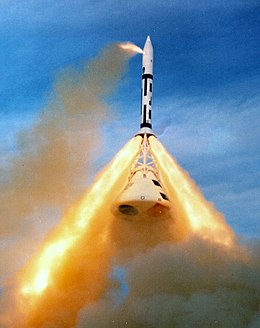
Project Mercury was the first human spaceflight program of the United States, running from 1958 through 1963. An early highlight of the Space Race, its goal was to put a man into Earth orbit and return him safely, ideally before the Soviet Union. Taken over from the US Air Force by the newly created civilian space agency NASA, it conducted 20 uncrewed developmental flights, and six successful flights by astronauts. The program, which took its name from Roman mythology, cost $2.57 billion. The astronauts were collectively known as the "Mercury Seven", and each spacecraft was given a name ending with a "7" by its pilot.

Soyuz 1 was a crewed spaceflight of the Soviet space program. Launched into orbit on 23 April 1967 carrying cosmonaut colonel Vladimir Komarov, Soyuz 1 was the first crewed flight of the Soyuz spacecraft. The flight was plagued with technical issues, and Komarov was killed when the descent module crashed into the ground due to a parachute failure. This was the first in-flight fatality in the history of spaceflight.

AS-201, flown February 26, 1966, was the first uncrewed test flight of an entire production Block I Apollo command and service module and the Saturn IB launch vehicle. The spacecraft consisted of the second Block I command module and the first Block I service module. The suborbital flight was a partially successful demonstration of the service propulsion system and the reaction control systems of both modules, and successfully demonstrated the capability of the command module's heat shield to survive re-entry from low Earth orbit.

The Apollo spacecraft was composed of three parts designed to accomplish the American Apollo program's goal of landing astronauts on the Moon by the end of the 1960s and returning them safely to Earth. The expendable (single-use) spacecraft consisted of a combined command and service module (CSM) and an Apollo Lunar Module (LM). Two additional components complemented the spacecraft stack for space vehicle assembly: a spacecraft–LM adapter (SLA) designed to shield the LM from the aerodynamic stress of launch and to connect the CSM to the Saturn launch vehicle and a launch escape system (LES) to carry the crew in the command module safely away from the launch vehicle in the event of a launch emergency.
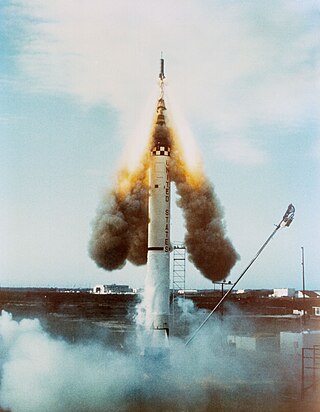
Mercury-Redstone 1 (MR-1) was the first Mercury-Redstone uncrewed flight test in Project Mercury and the first attempt to launch a Mercury spacecraft with the Mercury-Redstone Launch Vehicle. Intended to be an uncrewed sub-orbital spaceflight, it was launched on November 21, 1960 from Cape Canaveral Air Force Station, Florida. The launch failed in an abnormal fashion: immediately after the Mercury-Redstone rocket started to move, it shut itself down and settled back on the pad, after which the capsule jettisoned its escape rocket and deployed its recovery parachutes. The failure has been referred to as the "four-inch flight", for the approximate distance traveled by the launch vehicle.
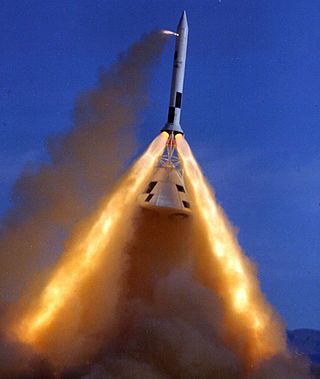
Pad Abort Test 2 was the follow-on second abort test to Pad Abort Test 1 of the Apollo spacecraft.

A-001 was the second abort test of the Apollo spacecraft.

A-002 was the third abort test of the Apollo spacecraft.

A-003 was the fourth abort test of the Apollo spacecraft. This particular flight is notable because during the abort test flight, an actual abort situation occurred, and further proved the Apollo launch escape system (LES). The CM was successfully pulled away from the malfunctioning Little Joe booster and it landed safely under parachutes.

A-004 was the sixth and final test of the Apollo launch escape vehicle and the first flight of a Block I production-type Apollo Command/Service Module.

Little Joe II was an American rocket used from 1963 to 1966 for five uncrewed tests of the Apollo spacecraft launch escape system (LES), and to verify the performance of the command module parachute recovery system in abort mode. It was named after a similar rocket designed for the same function in Project Mercury. Launched from White Sands Missile Range in New Mexico, it was the smallest of four launch rockets used in the Apollo program.
Apollo abort modes were procedures by which the nominal launch of an Apollo spacecraft, either the Saturn IB or Saturn V rocket, could be terminated. The abort of the flight allowed for the rescue of the crew if the rocket failed catastrophically. Depending on how far the flight had progressed, different procedure or modes would be used. In the history of the Apollo Program, none of the abort modes were ever used on any of the fifteen crewed Apollo spacecraft flights.

A launch escape system (LES) or launch abort system (LAS) is a crew-safety system connected to a space capsule. It is used in the event of a critical emergency to quickly separate the capsule from its launch vehicle in case of an emergency requiring the abort of the launch, such as an impending explosion. The LES is typically controlled by a combination of automatic rocket failure detection, and a manual activation for the crew commander's use. The LES may be used while the launch vehicle is still on the launch pad, or during its ascent. Such systems are usually of three types:

A boilerplate spacecraft, also known as a mass simulator, is a nonfunctional craft or payload that is used to test various configurations and basic size, load, and handling characteristics of rocket launch vehicles. It is far less expensive to build multiple, full-scale, non-functional boilerplate spacecraft than it is to develop the full system. In this way, boilerplate spacecraft allow components and aspects of cutting-edge aerospace projects to be tested while detailed contracts for the final project are being negotiated. These tests may be used to develop procedures for mating a spacecraft to its launch vehicle, emergency access and egress, maintenance support activities, and various transportation processes.
A pad abort test is a kind of test of a launch escape system which conducted by setting the system along with the spacecraft still on the ground and let the system activate to carry the spacecraft flying away, then separate in the air and make the spacecraft land safely. The purpose of the test is to determine how well the system could get the crew of a spacecraft to safety in an emergency on the launch pad. As the spacecraft is set still on the ground, the test is also called "zero-altitude abort test" in against "high-altitude abort test".

The Saturn V dynamic test vehicle, designated SA-500D, is a prototype Saturn V rocket used by NASA to test the performance of the rocket when vibrated to simulate the shaking which subsequent rockets would experience during launch. It was the first full-scale Saturn V completed by the Marshall Space Flight Center (MSFC). Though SA-500D never flew, it was instrumental in the development of the Saturn V rocket which propelled the first men to the Moon as part of the Apollo program. Built under the direction of Dr. Wernher von Braun, it served as the test vehicle for all of the Saturn support facilities at MSFC.

Gaganyaan is an Indian crewed orbital spacecraft intended to be the formative spacecraft of the Indian Human Spaceflight Programme. The spacecraft is being designed to carry three people, and a planned upgraded version will be equipped with rendezvous and docking capabilities. In its maiden crewed mission, the Indian Space Research Organisation (ISRO)'s largely autonomous 5.3-metric ton capsule will orbit the Earth at 400 km altitude for up to seven days with a two- or three-person crew on board. The first crewed mission was originally planned to be launched on ISRO's LVM3 rocket in December 2021. As of September 2023, it is expected to be launched by mid-2024.
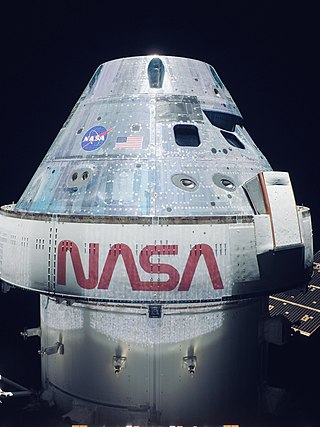
Orion is a partially reusable crewed spacecraft used in NASA's Artemis program. The spacecraft consists of a Crew Module (CM) space capsule designed by Lockheed Martin and the European Service Module (ESM) manufactured by Airbus Defence and Space. Capable of supporting a crew of four beyond low Earth orbit, Orion can last up to 21 days undocked and up to six months docked. It is equipped with solar panels, an automated docking system, and glass cockpit interfaces modeled after those used in the Boeing 787 Dreamliner. A single AJ10 engine provides the spacecraft's primary propulsion, while eight R-4D-11 engines, and six pods of custom reaction control system engines developed by Airbus, provide the spacecraft's secondary propulsion. Orion is intended to launch atop a Space Launch System (SLS) rocket, with a tower launch escape system.
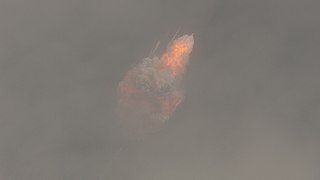
SpaceXCrew Dragon In-Flight Abort Test was a successful test of the SpaceX Dragon 2 abort system, conducted on 19 January 2020. It was the final assessment for the Crew Dragon capsule and Falcon 9 launch system before they would be certified to carry humans into space. Booster B1046.4 and an uncrewed capsule C205 were launched from Launch Complex 39A (LC-39A) on a suborbital trajectory, followed by an in-flight abort of the capsule at max Q and supersonic speed. The test was carried out successfully: the capsule pulled itself away from the booster after launch control commanded main engine shutdown and landed safely.
